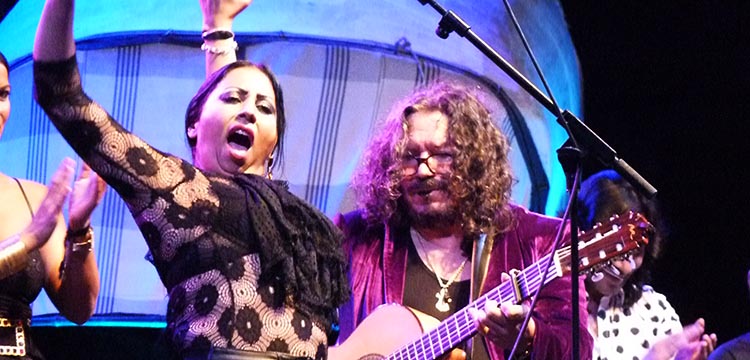63rd POTAJE GITANO DE UTRERA
Saturday, June 29th, 2019. 10:20 pm. Colegio Salesiano, Utrera
Tribute to Raimundo Amador
Voice: Mari Peña, José Valencia, Remedios Amaya. Dance: El Farru and his group. Familia Amador: Raimundo Amador, Juan José Amador, Luis Amador, Carmen Amador, Manuel Amador, Antonio Amador, Toñi Amador, Raimundo Amador, Jr., Luis Amador Amador. Raimundo with his Band: Manuel Romero Jero (flamenco guitar), Humberto Girón (electric guitar), Roberto Chacón (keyboard), Rosario Heredia (voice and chorus), Raimundo Amador (percussion).
Text & photos: Estela Zatania
Arriving at the spacious patio of the Salesiano school in Utrera, I immediately felt the cozy sensation that flamenco is still current in this town just southeast of Seville. Perhaps it’s nostalgia, resistance to change or as some people might say, stubbornness, I don’t know, but you see the friends from last year, fellow journalists, performers, that rustic cart that decorates the stage, and you know there’s going to be singing, dancing and guitar of the kind you learned to love so long ago.
Well, the mental script goes like that, although there might be some variation. Such as the presence of Raimundo Amador with numerous relatives, and if you don’t think so, check out the cast at the top of this article. Good ol’ Raimundo, one of the most creative and important musicians of the country, object of this year’s tribute, is turning 60 (they tell me that’s “old”, I don’t get it…).
But let’s begin at the beginning. Things got underway with the sweet voice of Mari Peña, accompanied by the guitar of her experienced and knowledgeable husband, Antonio Moya. They delivered the Utrera sound, recalling voices of elder singers no longer with us, because Utrera has a special flavor, different from that of other flamenco singing zones. Soleá, serene and elegant, passing through “the mines of Egypt” and other classic styles. Cantiñas of Pinini and bulerías were also included.
José Valencia from Lebrija with his sidekick Juan Requena on guitar delivered their no-nonsense sound with a powerful assortment of soleá styles. Abandolao forms for the new millennium, fresh but classic, included a fine flamenco jabera. For siguiriyas, we had to fasten our seat-belts to receive Valencia’s strength which did not let up. Bulerías… And the singer took right over…chairs, tables, spotlights, projection screens…everything became his with living breathing dynamic flamenco.
Eurovision is just a faint memory, isn’t that so Reme? Now you’re the boss and you guide the boat all on your own. Remedios Amaya is an old hand with a mega personality, so much so that you don’t know if it’s more music or charisma, and it doesn’t even matter. Her open-ended phrasing becomes a monologue, and the numerous audience jump up from their seats again and again. In bulerías, she pushes the possibilities to the limits of her own imagination with inspired phrasing.
And Raimundo! At first, if the truth be told, and that’s what we’re aiming for, the laidback blues sound was like a bucket of cold wáter after all the above-mentioned flamenco energy. If music transports us to other landscapes, many of us felt as if we’d gotten off at the wrong station. But things got straightened out just in time with “Ay José, yo te canto Camarón”, the definitive ballad of the late nineteen-eighties. Everything went along fine from that point on with songs and pieces of varying flamenco-ness, soleá to electric guitar, I mean a real lesson in tolerance that reminded us all that flamenco can pop up where and when you least expect it.
Then came the protocol of the actual tribute, and bean stew for two thousand people, and we still were to see Farru with the guitar of Román Vicenti and cantaor Antonio Villar, in addition to the Amador family just in case anyone was left needing some more flamenco.
